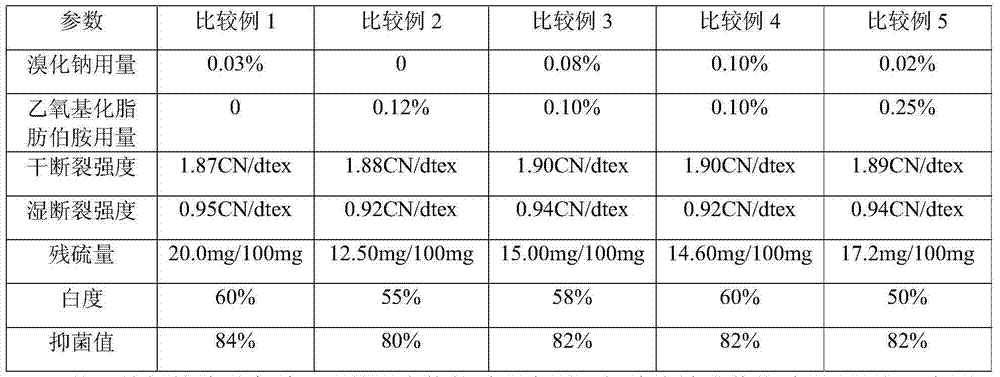Regenerated cellulose fibers and preparation method thereof
A technology of regenerated cellulose and type A cellulose, which is applied in the chemical characteristics of fibers, rayon manufacturing, and rayon made of viscose, etc. It can solve the problems of environmental impact, consumption of large chemicals, and low utilization rate of raw materials.
- Summary
- Abstract
- Description
- Claims
- Application Information
AI Technical Summary
Problems solved by technology
Method used
Image
Examples
Embodiment 1
[0071] Cooking: using bamboo as raw material, using pre-hydrolyzed sulfate method for cooking, cooking temperature 155°C, cooking 60 minutes under the condition of 0.5MPa pressure, the amount of alkali is 15% of the absolute dry raw material in terms of sodium oxide, and the degree of sulfidation is 8 %, the liquid ratio is 1:2.5; the degree of polymerization of the slurry after cooking is 1050;
[0072] Adjust the degree of polymerization: add sodium bromide and chlorine dioxide to the slurry after cooking, the amount of sodium bromide added is 0.05% of the absolute dry pulp, and the amount of available chlorine added is 2% of the absolute dry pulp. ℃ treatment for 0.6 hours, the adjusted degree of polymerization of wood pulp cellulose is 580, and the whiteness is 60%;
[0073] Acid treatment: It is necessary to pickle the pulp after adjusting the degree of polymerization with hydrochloric acid, the amount of hydrochloric acid is 3% of the absolute dry pulp, and the time is 9...
Embodiment 2
[0081] Cooking: use hemp as raw material to cook by kraft method, cooking temperature is 170°C, and cooking is under the condition of 0.7MPa for 100 minutes. The liquid ratio is 1:4; the degree of polymerization of the slurry after cooking is 550;
[0082] Adjust the degree of polymerization: Add sodium bromide and chlorine dioxide to the slurry after cooking, the amount of sodium bromide added is 0.01% of the absolute dry pulp, and the amount of available chlorine is 0.5% of the absolute dry pulp, at a temperature of 30°C Treated for 1.8 hours, the adjusted degree of polymerization of wood pulp cellulose is 450, and the whiteness is 35%;
[0083] Acid treatment: It is necessary to pickle the slurry after adjusting the degree of polymerization with hydrochloric acid, the amount of hydrochloric acid is 5% of the absolute dry slurry, and the time is 30 minutes;
[0084] Dipping: The pulp after pickling, desanding and concentration is soaked in sodium hydroxide solution containi...
Embodiment 3
[0091] Cooking: use wood as raw material, cook with pre-hydrolyzed sulfate method, cook at a temperature of 160°C, and cook for 80 minutes under a pressure of 0.6MPa. %, the liquid ratio is 1:6, and the degree of polymerization of the slurry after cooking is 850;
[0092] Adjust the degree of polymerization: Add sodium bromide and sodium hypochlorite to the slurry after cooking, the amount of sodium bromide added is 0.03% of the absolute dry pulp, the amount of available chlorine is 0.5% of the absolute dry pulp, and it is treated at a temperature of 40 ° C for 1.4 hour, the adjusted degree of polymerization of wood pulp cellulose is 500, and the whiteness is 50%;
[0093] Acid treatment: It is necessary to pickle the slurry after adjusting the degree of polymerization with hydrochloric acid, the amount of hydrochloric acid is 1% of the absolute dry slurry, and the time is 60 minutes;
[0094] Dipping: The pulp after pickling, desanding and concentration is soaked in sodium h...
PUM
| Property | Measurement | Unit |
|---|---|---|
| degree of polymerization | aaaaa | aaaaa |
| degree of polymerization | aaaaa | aaaaa |
| degree of polymerization | aaaaa | aaaaa |
Abstract
Description
Claims
Application Information
 Login to View More
Login to View More - R&D
- Intellectual Property
- Life Sciences
- Materials
- Tech Scout
- Unparalleled Data Quality
- Higher Quality Content
- 60% Fewer Hallucinations
Browse by: Latest US Patents, China's latest patents, Technical Efficacy Thesaurus, Application Domain, Technology Topic, Popular Technical Reports.
© 2025 PatSnap. All rights reserved.Legal|Privacy policy|Modern Slavery Act Transparency Statement|Sitemap|About US| Contact US: help@patsnap.com

